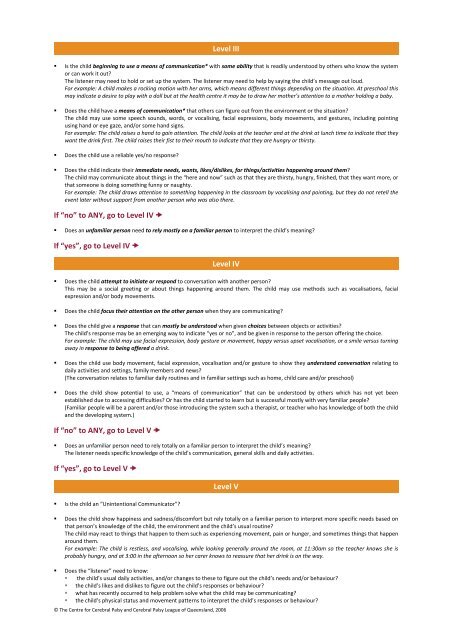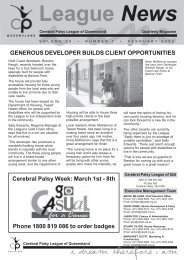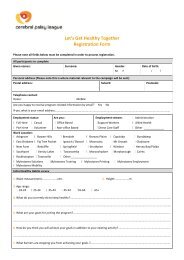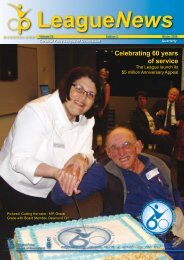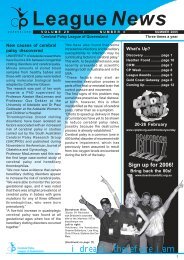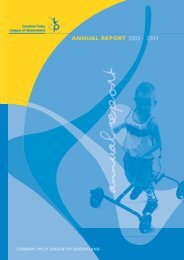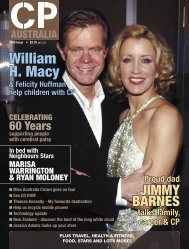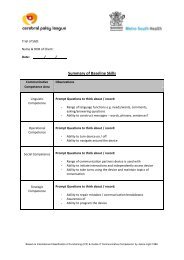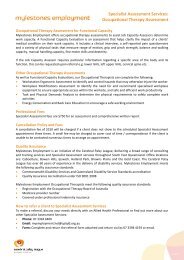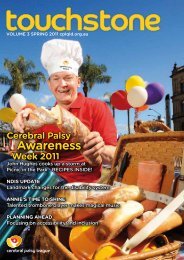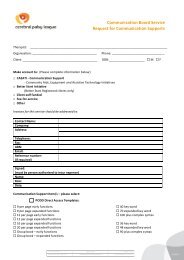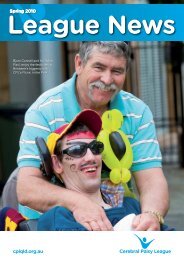Functional Communication Classification System - Cerebral Palsy ...
Functional Communication Classification System - Cerebral Palsy ...
Functional Communication Classification System - Cerebral Palsy ...
- No tags were found...
Create successful ePaper yourself
Turn your PDF publications into a flip-book with our unique Google optimized e-Paper software.
Level III• Is the child beginning to use a means of communication* with some ability that is readily understood by others who know the systemor can work it out?The listener may need to hold or set up the system. The listener may need to help by saying the child’s message out loud.For example: A child makes a rocking motion with her arms, which means different things depending on the situation. At preschool thismay indicate a desire to play with a doll but at the health centre it may be to draw her mother’s attention to a mother holding a baby.• Does the child have a means of communication* that others can figure out from the environment or the situation?The child may use some speech sounds, words, or vocalising, facial expressions, body movements, and gestures, including pointingusing hand or eye gaze, and/or some hand signs.For example: The child raises a hand to gain attention. The child looks at the teacher and at the drink at lunch time to indicate that theywant the drink first. The child raises their fist to their mouth to indicate that they are hungry or thirsty.• Does the child use a reliable yes/no response?• Does the child indicate their immediate needs, wants, likes/dislikes, for things/activities happening around them?The child may communicate about things in the “here and now” such as that they are thirsty, hungry, finished, that they want more, orthat someone is doing something funny or naughty.For example: The child draws attention to something happening in the classroom by vocalising and pointing, but they do not retell theevent later without support from another person who was also there.If “no” to ANY, go to Level IV •• Does an unfamiliar person need to rely mostly on a familiar person to interpret the child’s meaning?If “yes”, go to Level IV •Level IV• Does the child attempt to initiate or respond to conversation with another person?This may be a social greeting or about things happening around them. The child may use methods such as vocalisations, facialexpression and/or body movements.• Does the child focus their attention on the other person when they are communicating?• Does the child give a response that can mostly be understood when given choices between objects or activities?The child’s response may be an emerging way to indicate “yes or no”, and be given in response to the person offering the choice.For example: The child may use facial expression, body gesture or movement, happy versus upset vocalisation, or a smile versus turningaway in response to being offered a drink.• Does the child use body movement, facial expression, vocalisation and/or gesture to show they understand conversation relating todaily activities and settings, family members and news?(The conversation relates to familiar daily routines and in familiar settings such as home, child care and/or preschool)• Does the child show potential to use, a “means of communication” that can be understood by others which has not yet beenestablished due to accessing difficulties? Or has the child started to learn but is successful mostly with very familiar people?(Familiar people will be a parent and/or those introducing the system such a therapist, or teacher who has knowledge of both the childand the developing system.)If “no” to ANY, go to Level V •• Does an unfamiliar person need to rely totally on a familiar person to interpret the child’s meaning?The listener needs specific knowledge of the child’s communication, general skills and daily activities.If “yes”, go to Level V •• Is the child an “Unintentional Communicator”?Level V• Does the child show happiness and sadness/discomfort but rely totally on a familiar person to interpret more specific needs based onthat person’s knowledge of the child, the environment and the child’s usual routine?The child may react to things that happen to them such as experiencing movement, pain or hunger, and sometimes things that happenaround them.For example: The child is restless, and vocalising, while looking generally around the room, at 11:30am so the teacher knows she isprobably hungry, and at 3:00 in the afternoon so her carer knows to reassure that her drink is on the way.• Does the “listener” need to know:• the child’s usual daily activities, and/or changes to these to figure out the child’s needs and/or behaviour?• the child’s likes and dislikes to figure out the child’s responses or behaviour?• what has recently occurred to help problem solve what the child may be communicating?• the child’s physical status and movement patterns to interpret the child’s responses or behaviour?© The Centre for <strong>Cerebral</strong> <strong>Palsy</strong> and <strong>Cerebral</strong> <strong>Palsy</strong> League of Queensland, 2006


